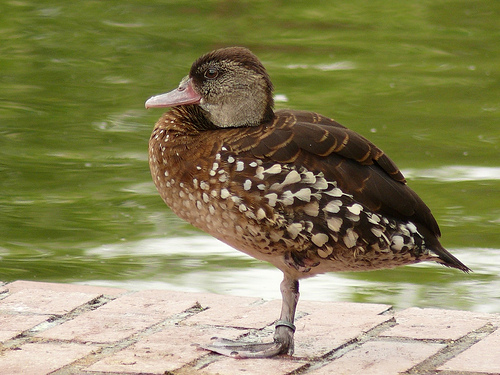
Spotted whistling duck(Dendrocygna guttata)
Phylum —chordata
Class — aves
Order — anseriformes
Family — anatidae
Genus –dendrocygna
Appearance
The spotted whistling duck has a grey head with a dark crown and hind neck, dark-brown eyes, a pink-grey beak, a chestnut-brown breast with small white spots, brown flanks with large white spots, underparts are whitish. Upperparts and tail are dark-brown, wings are dark-brown, and legs are reddish-grey.
Weight – 0,7-0,9 kg, height – 45 cm about.
Habitat
Spotted whistling ducks occupy an extensive range that extends from the East Indies south to New Guinea.
Behavior
Spotted whistling ducksloaf and preen on shaded grassy banks and favor wetlands and scattered trees along the shore that enable the ducks to readily perch over water, in waterside trees, as well as on partly submerged logs and floating mats of vegetation. They feed and roost collectively, and they are not inclined to form concentrations as large as most other whistling-ducks. At late twilight and even after dusk, larger gatherings that can number in the hundreds fly to the tops of tall trees before winging out to feeding sites.
Surprisingly efficient divers, spotted whistling ducks can remain submerged for up to 20 seconds.
Diet
The spotted whistling duck eat exclusively plant food and only occasionally accidentally catch invertebrates that live in water. The birds eat seeds, leaves of aquatic plants, extracting them with their beak when dipping their heads under the water.
Reproduction
The prolonged reproductive season probably starts at the onset of the initial rains in September. Perhaps the most arboreal of the tribe, nesting pairs are reliant on tall, hollow trees, particularly those in or near water.
In captivity
Lifespan can reach 20 years.
Ducks of this genus are social species that get along peacefully with representatives of their own genus and those ones of other genera in large mixed groups on the same site, so it is possible to keep birds of different species in one spacious aviary outside the breeding season. It is only advisable to make sure that these are ducks of approximately the same size, since larger ones can make smaller ones go away from the feeder and drinker.
Ducks feel great on the territory where there are tall grasses, shrubs and trees and a reservoir at least 1 m deep, the size of which allows them to swim. The area of the fenced yard should correspond to the number of birds contained, providing it with the opportunity to retire and hide. Small shelters on the top of the open area in the form of sheds, huts and booths are necessary as shelters from birds of prey, bad weather, as well as for overnight stays. Building aviaries, you should take into account the desire of the bird to fly. Owners usually cover them from above or make regular trimming of the wings.
In winter, ducks, being mainly tropical inhabitants, need reliable protection from the cold. Capital buildings with deep straw bedding or a thick layer of sawdust will protect the bird from hypothermia and frostbite in the winter. Depending on the severity of the climate, it is necessary to provide a variety of ways to warm up the winter room when the temperature drops from 0 оС and below.
Tree ducks are mostly monogamous and nest in colonies, but during the breeding season it is necessary to settle birds of different species to avoid hybridization. Mixing of species occurs rarely, and only when there is an excess of sexually mature males that do not have a permanent pair. On the nesting site, various locations are organized for laying eggs: boxes and houses on the ground,which also can be raised 1 meter or higher from its surface.
It is quite simple to provide full nutrition to tree ducks in captivity. A variety of grain mixes and pellets are suitable for feeding them. Ducks need drinkers with a sufficient amount of clean water, especially if there is not even a small pond for swimming.
Ducklings grow well when the keepers start giving them standard feeds, and enjoy eating chopped lettuce or spinach leaves. Artificially bred сhicks sometimes do not eat well during their first days, so keepers add boiled eggs or mealworms to their food. It is important to provide pairs of ducks with a brood with the opportunity to graze on fresh grass or give access to shallow reservoirs overgrown with aquatic vegetation (duckweed, reeds, etc.). Such conditions of keeping contribute to better preservation and growth of young birds. Daily bathing under the control of adult birds is safe.
 Russian
Russian
 English
English
























